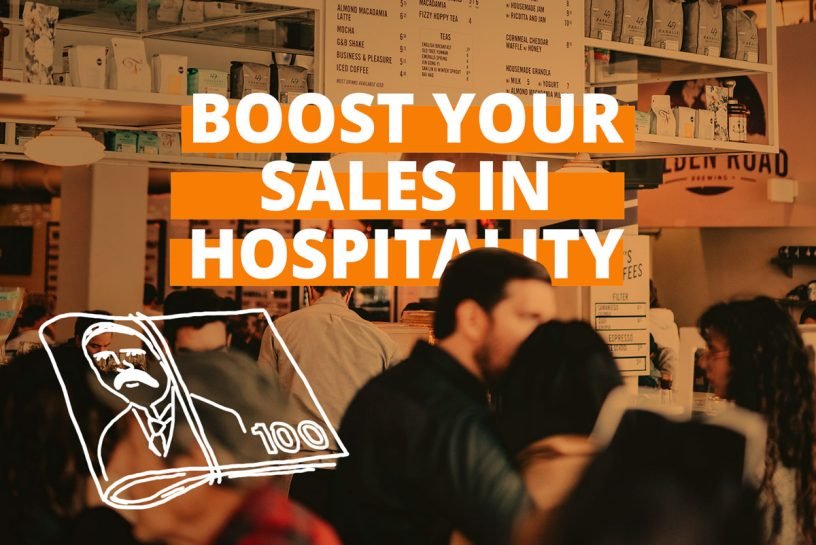Foot traffic flowing into a hospitality business is rarely consistent. The number of people who come to your hospitality business is determined by several factors. These may include seasonality, the competition around you, the economy, and many other factors.
Regardless of how much foot traffic flows in, we can always feel like we could do more to get people coming through our business’ door.
Even the most successful hospo businesses have room for improvement in certain areas. For example, in the recent decade, hospo business owners have believed that paying for advertisements is the best way to increase restaurant traffic, e.g.: Facebook ads. Despite playing a major role in building your brand, it can be a costly venture that may not guarantee a return on investment in time and money if not done with the proper expertise.
If you’re open to learning and want to increase the foot traffic of your hospitality business, try investing time and money into the seven ideas outlined here to increase your number of guests in a more personalised, effective, and modern way.
Topics at a glance:
Encouraging Online Orders
Use of Social Media
Guest Loyalty Program Ideas
Google Business Matters
Proper Use of Tech in Hospitality
Create Your Menu – Consciously
Turn Your Guest Into Your Promoters
Conclusion
1. Encouraging Online Orders
Consumers have many options for deciding where to go out for dinner. We want to ensure to help them with their decision-making. If we smoothen our operations from a guest’s point of view, there is a higher chance they will come to us. The dining experience process, in other words, the “purchasing process”, must be made as quick and straightforward as possible. Online and offline. We must beat our competitors in this matter.
“The smoother the process, the better.“
If you offer your guests online ordering (in this case, food ordering), there are plenty of online ordering apps and software to choose from. If you use an alternative for food ordering, such as direct calls, make sure someone will answer the phone every time it rings. A useful tip! Use a different number so that calls for reservations and orders do not come in on the same number.
In case when a guest or a delivery person arrives to pick up the order, do not make them wait. Set up the system so these guests can receive their food out of the queue.
With takeout food, there are some business benefits. For example, there is no table service. This allows the kitchen and staff to produce more orders in a shorter time, which can be beneficial for generating revenue. Do not let the process fail at food pickup!
“Everybody wants a smooth experience in any area of their everyday life.“
Think about what you consider essential when YOU go out for dinner. And translate it to your business. Make processes more effortless, and if you have the capacity, increase sales with the introduction of online food ordering. By providing your guests with the ability to order food from a computer or smartphone, you make it easier for your restaurant to be discovered in the jungle of the internet.
Useful tip! You do not have to offer the whole menu for takeaways. Make a selection, and list specific items only. It is up to you what you sell for takeaways or delivery.
2. Use of Social Media
Nowadays, hospitality businesses have countless opportunities to advertise themselves and their activities on social media. Building a brand is still essential in marketing.
“The importance of brand building did not change; the tools you can use did.“
It would be foolish not to take advantage of the opportunities offered by social media, which cost nothing. If you haven’t done so already, why not?
As mentioned, social media is entirely free, and most importantly, it allows for personal communication with clients.
How can you use it?
Respond to your followers’ questions and comments, and share photos of your people, food, processes and behind-the-scenes moments. You could communicate exclusive offers.
“You can create a community for your business beyond the walls of your hotel, restaurant or cafe.“
This is the power of social media, in my opinion.
Social media helps your business easily stick in people’s minds. With that, it increases the chance that a potential customer will choose your restaurant when faced with a choice. Thereby social media presence has the potential to increase future sales.
3. Initiating a Loyalty Program
To increase the turnover of our hospitality business overnight, let’s focus on our established clientele instead of trying to acquire new guests. This is because the latter is much more expensive and difficult to get. The initiation of different loyalty programs is the perfect solution for this.
According to online statistics, members of a loyalty program in a given restaurant spend, on average, 19% more when redeeming their rewards than they usually do. And the frequency of their visits to the restaurant also increases by about 75% between the first and tenth reward redemption.
One of the natural side effects of a loyalty program will be an increase in the number of guests, as those who go out for dinner, for example, will not do so alone but with their colleagues, friends, or family.
I have shared a concrete tip in my NZ Small Business Marketing Group on Facebook: https://www.facebook.com/groups/nzsmallbusinessmarketing
4. Why is a Google Business Profile important?
If you haven’t done so, register your business (restaurant, coffee shop, or hotel) – set up your Google Business Account NOW!
A Google Business Profile is essential for your business.
Registering your hospitality business on Google will help you receive credibility in its online presence. Furthermore, Google Business is one of the most critical factors in Local Marketing, which will generate customers from the local area you serve.
In this article, I have explained further about Local Marketing: https://blog.shopographic.com/quick-marketing-tips/google-business-solutions/
When someone searches online for a service or product like yours, your profile might show up if Google Business is optimised well. With that, people can view every detail of your business, such as your business hours, website, exact address, products, services, and photos. All essential info is in one place.
A Google Business Profile is only one aspect of making your customer acquisition process frictionless for your potential customers. Thus, they can find your business, place an order, or book a room easier. The best part is setting up your business on Google only takes about 15 minutes. Optimalisation though? It is a different game that takes longer. That is what I do.
Check out my comprehensive, free, no-email-needed checklist!!
Google Business Profile Optimisation - FREE Checklist
I have compiled a comprehensive checklist with my tips that you can download for free today.
- It is a simple step-by-step guide.
- You will optimise your Google Business Profile with it.
- You will also improve your SEO.
- All that in a few hours by going through my checklist.
I explain what you are getting in a 2 minute video on the page linked below.
Free to download, NO email address in exchange needed.
Click here to read more or watch the video.
5. Proper Use of Technology in Hospitality
Slow and outdated computers and unreliable systems can slow down payment and ordering processes. Places where they still use handwritten orders can be a breeding ground for serious errors among the kitchen staff, for example.
People go to a hotel, restaurant or cafe for two reasons only:
- Need – e.g.: they need to have a quick and affordable lunch during the day.
- Experience – e.g.: they want to feel special, have fun or repeat a great experience.
I am going to touch on ‘experience’ now.
We all know that there is nothing more important in the life of a successful hospitality business than the experience we offer to guests. This is the reason why we can keep the doors open.
“Guests with good experiences will return and spend more money at our business.“
Unfortunately, problems like the one mentioned before about unreliable systems will negatively affect the guest experience. Outdated methods are called outdated for a reason. It’s time for a change. As we all experienced, in most cases, these systems break down exactly when they are needed the most. In the middle of the busiest period. I won’t even start on how much money can be lost from a poorly handled, chaotic situation.
Without a reliable POS system and proper functions, the restaurant’s efficiency is limited. It limits the number of sales processed during a given period.
Outdated technology can be frustrating for both employees and guests, resulting in both of them potentially turning away and leaving the business.
Instead, you need to ensure the implementation and use of a modern POS system. POS systems with adequate reporting functions will simplify your accounting operations. Also, it will make it easier to access all the data you need to track the growth of your hospitality business.
6. Create your menu, but consciously!
Have you considered this before? There could be items on your menu that affect the sales within your restaurant. How? For example, by showing a much weaker sales rate than you expected, contrary to your expectations. It may be that the food or drink priced for the most significant profit is too expensive for your guests, and you sell less of it.
It may be time to take off the menu the dishes that your guests hardly order. It might be necessary to refresh your pricing model.
The only way to be sure of answering the above questions is to launch a well-thought-out and pre-structured menu planning. Let’s look for strategic considerations on what dishes we will put on the menu. What “food cost” will they have, and based on these, how will we determine our prices to increase profit in our restaurant business?
In places where I used to work, we have been working with a food (or drink) cost of around 10-30%. Faster-moving items had a more significant profit margin (50-60%) than slower-moving items. Those have smaller profit margins. But that is also not necessarily true. High-class, luxury places tend to work with even higher profit margins. It depends on the brand.
Example:
Imagine an excel sheet. With columns. All your items are listed in the first column. All items have their cost calculated in the second column. You work with that price. In the third column, you calculate the price you want to sell it. In the fourth, you have a percentage calculator that tells you, based on the cost and sale price, what cost percentage you are working with on that particular item. At the bottom of the fourth column, you can see a total balance of cost percentage. In general, if you can aim to have it sitting around 20-30% is great.7. Let your customers be your promoters
This should be completely obvious – but you can’t expect your business to grow without quality food, appearance, and excellent service.
“To this day, there is no stronger marketing than word of mouth when a message spreads from one person to another.“
Gossip is extremely powerful, especially in a negative sense.
What do I mean by that?
While a satisfied customer will share their positive experience with about three acquaintances, an unhappy customer will share their grievances and negative experience with at least ten others.
Shocking, right?
Furthermore, they will happily shout it into the world for others to know about. Following this thought:
“you can permanently lose potential customers who haven’t even walked through your door yet due to unhappy customers.“
Don’t let this happen! Your hospitality business must provide an exceptional experience for every visitor to grow successfully.
Conclusion
Nowadays, there are around 23,000 hospitality establishments in New Zealand. This is a good sign for the industry. Hopefully, more and more hotels, restaurants and cafes can stay open year by year.
However, over-saturation can make it harder for hospo businesses to survive. This is why it’s so crucial for you to take advantage of every small measure you can to:
- up your marketing,
- smoothen processes and
- turn your guest into loyal fans.
If you want your hospitality business to stand out, embrace my seven simple tips for increasing your sales.
I hope this post has generated ideas for some business owners.
Follow this blog as I share hands-on marketing tips with readers that I find helpful.
Thank you for reading my post.
I am Shopi.
The No B.S. Marketing & Design Guy for Hospitality Businesses.




